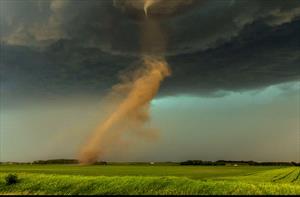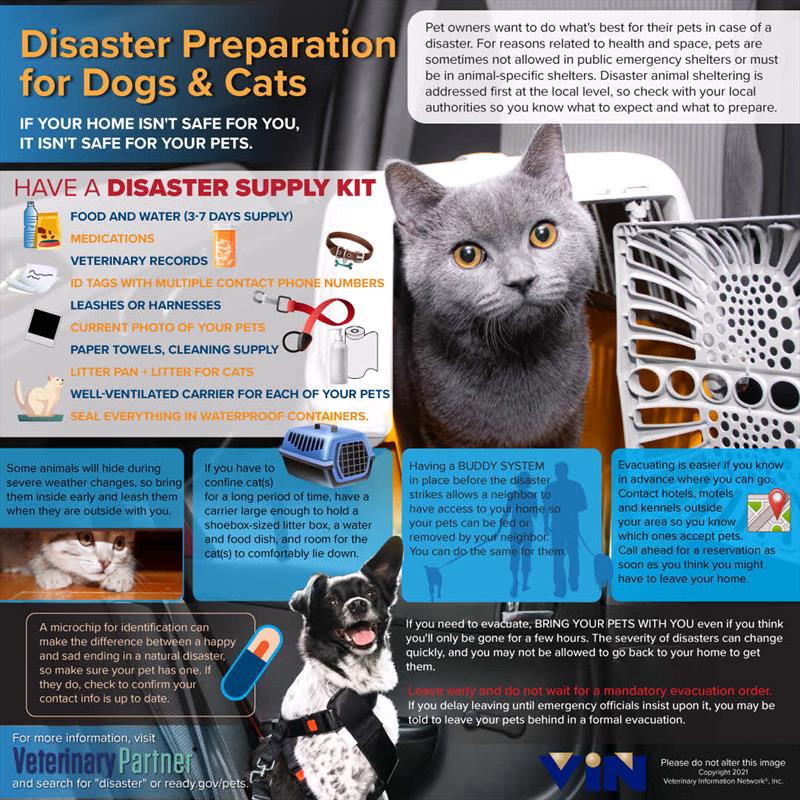Tornado

Photo courtesy of Amanda L. Hill/NOAA
Pet owners want to do what's best for their pets in case of a disaster. For reasons related to health and space, pets are sometimes not allowed in public emergency shelters or must be in animal-specific shelters. Disaster animal sheltering is addressed first at the local level, so check with your local authorities once a year, typically in the early spring, so you know or remember what to expect. The worst scenario, leaving your pets at home, can usually be avoided.
The Humane Society of the United States (HSUS), the Federal Emergency Management Agency (FEMA), and the American Red Cross work together in the U.S. during disasters. The agencies agree that you should keep your pets with you if at all possible, and agree that if your home isn't safe for you, it isn't safe for your pets.
The HSUS recommends that you put together a disaster supply kit packed in a waterproof container for your pets. The container should have three days to a week's worth of food and water, medications, veterinary records, leashes or harnesses, a current photo of your pets for identification purposes, paper towels, litter pan and litter if you have a cat, sealable plastic bags, and an extra leash and collar. Use flip-top canned food or include a can opener. Place the photos in a sealable plastic bag. These items will be of use whether you evacuate or are sheltered in place. If your pet has medication that must be kept cool, keep the medication in one of the sealable plastic bags and ice it with ice from the Red Cross. The HSUS recommends that you have a carrier for each one of your pets.
Replace the food in your disaster kit on a regular basis so that it doesn't spoil. Temporary paper tags from an office supply store can be used as alternative identification tags could be useful if you need to put a relative's phone number on the pet.
The Cat Fanciers' Association recommends that if you have to confine cat(s) for a long period of time, have a carrier large enough to hold a shoebox-sized litter box, a water and food dish, and room for the cat(s) to comfortably lie down. Ensure the carrier is properly ventilated and not left in the sun. The Association says that if you must take the cat out, do so in a confined space as the cat may try to run away.
If you shelter in your own place, keep an eye on their whereabouts in case you need to evacuate. It's best to bring them inside. Some animals will hide during severe weather changes, so bring them inside early and leash them when they are outside with you. Keep plastic bags and newspapers inside to clean up pet waste.
Having a buddy system in place before the disaster strikes is helpful, particularly if you are not at home when the disaster hits but your pets are. The buddy system allows a neighbor to have access to your home so your pets can be fed or removed by your neighbor. You can do the same for them.
If you need to evacuate, bring your pets with you even if you think you'll only be gone for a few hours; the severity of disasters can change quickly, and you may not be allowed to go back to your home to get them. It will help calm your pet if you bring a favorite blanket or toys.
Evacuating will be much easier if you already know in advance where you can go. Both the HSUS and FEMA suggest you contact hotels and motels outside your area so you know which ones accept pets; ask in advance about any restrictions on number, size, and species. Also ask if no pet policies are waived in an emergency. Make a list of the places you can go to and keep it with your emergency phone numbers; include area kennels on your list. Call ahead for a reservation as soon as you think you might have to leave your home.
Some local animal shelters allow pets to stay there during an emergency; find out in advance if yours does. Shelters have limited resources and space and their energies will be elsewhere during an emergency, so use this as a last resort.
FEMA urges people to leave early and not wait for a mandatory evacuation order. If you delay leaving until emergency officials insist upon it, you may be told to leave your pets behind in a formal evacuation.
Unfortunately, there are times when no matter how solid your plans are, the specifics of the emergency dictate that your pets must remain at home. If your dog normally wears a chain link choker collar, have a leather or nylon collar available if you have to leave the dog alone for several days. FEMA suggests that you leave a two or three day supply of dry food, even if it's not the pet's usual food. Don't moisten the food. Leave the food in a sturdy container that the pet cannot overturn. Leave water in a no-spill container. If possible, open a faucet slightly and let the water drip into a big container. Large dogs may be able to obtain fresh water from a partially filled bathtub. Leave the pets in the safest room in the house, such as a basement or bathroom.
Other Pets
Birds
The American Red Cross suggests that birds should be transported in a secure travel cage or carrier. In cold weather, wrap a blanket over the carrier and warm up the car before placing birds inside. During warm weather, carry a plant mister to mist the birds' feathers periodically. Do not put water inside the carrier during transport. Put some fresh fruits and vegetables with high water content in the carrier. Have a photo for identification and leg bands. If the carrier doesn't have a perch, line it with paper towels and change them frequently. Don't let the birds out of the cage or carrier.
Reptiles
Snakes can be transported in a pillowcase but they must be transferred to more secure housing when they reach the evacuation site. If your snakes require frequent feedings, carry food with you. Take a water bowl large enough for soaking as well as a heating pad. When transporting house lizards, follow the same directions as for birds. For more information, see Emergency Planning for Reptile and Amphibian Collections.
Small Mammals
Small mammals (hamsters, gerbils, rabbits, guinea pigs, etc.) should be transported in secure carriers suitable for maintaining the animals while sheltered. Take bedding materials, food bowls, and water bottles.
Livestock and Horses
Livestock and horses have specific disaster needs that must be planned for in advance.
Disaster Prep 2021

Graphic by VIN
Additional Resources
Saving the Whole Family, AVMF
Prepare your Pets for Disasters, FEMA
Pet Disaster Preparedness, Red Cross
Pet Disaster Preparedness, Red Rover